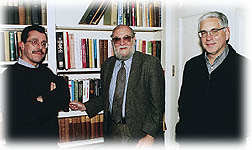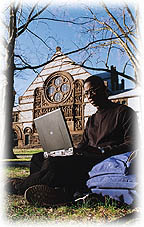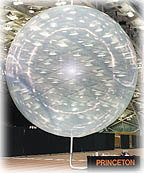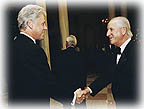Notebook - December 15, 1999
Hellenic Studies celebrates 20
years
Images of the Parthenon, Zeus, and Homer may spring to mind when you
think of Greece, but what of Byzantine monasteries, El Greco, Maria Callas,
and Nobel Prize-winning poets such as George Seferis? The Hellenic world's
literature, art, and thought, indubitably inspired the Western world for
centuries and continues to through its modern culture; Princeton's Program
in Hellenic Studies, currently celebrating its 20th anniversary, embraces
all of it.
 "The Hellenic world is a mirror, a dark crystal, into which we
tend to see our reflection, refraction, or antithesis. That's the idea behind
Hellenic Studies at Princeton. We study Greek culture for its own sake,
and also to seek out what's relevant in it for understanding the world at
large," said Dimitri H. Gondicas '78, (on the left in picture) executive
director of the program.
"The Hellenic world is a mirror, a dark crystal, into which we
tend to see our reflection, refraction, or antithesis. That's the idea behind
Hellenic Studies at Princeton. We study Greek culture for its own sake,
and also to seek out what's relevant in it for understanding the world at
large," said Dimitri H. Gondicas '78, (on the left in picture) executive
director of the program.
Given Princeton's strong tradition in Classics (which focuses on Classical
Greek literature, history, art, archaeology, and philosophy), Hellenic Studies'
mission is to strengthen teaching and research on the post-Classical Greek
world, including the Late Antique, Byzantine, Ottoman, and modern Greek
periods. Since 1979, the program has grown from two to 20 courses. It now
offers an undergraduate concentration and graduate opportunities, including
a Ph.D. in Classical and Hellenic Studies.
"The program . . . brings together people from different disciplines
who share Hellenic interests," said vice-president and secretary Thomas
H. Wright, Jr. '62, who has served as a trustee since Stanley J. Seeger,
Jr. '52 *56 made the founding gift. Seeger's funding coupled with strong
appointments and abundant offerings have allowed Hellenic Studies to become
the premier academic program of its kind in the U.S., said Wright.
A burst of activity has accompanied this 20th anniversary. In November,
the program hosted the 30th anniversary Symposium of the Modern Greek Studies.
And scholars associated with the program are busy publishing: among them
are Edmund L. Keeley '48 (in center, pictured above), a former program director
and the Charles Barnwell Straut Class of 1923 Professor of English, Emeritus
(Inventing Paradise: The Greek Journey 1937-47), program director and Edmund
N. Carpenter II Class of 1943 Professor in the Humanities Alexander Nehamas
*71 (The Art of Living: Socratic Reflections from Plato to Foucault, pictured
above on right), and coeditors Gondicas and Bayard Dodge Professor of Near
Eastern Studies Emeritus Charles P. Issawi (Ottoman Greeks in the Age of
Nationalism).
-Maria LoBiondo
Endowment hits $6.5 billion
Princeton's pockets are bulging. As of June 30, its endowment grew to
$6.5 billion, said Andrew K. Golden, president of Princeton University Investment
Company (Princo). For decades, the university has had the highest endowment
per student in the nation, he said. In 1998 it was $875,321, ranking first
among institutions that educate undergraduates, according The Chronicle
of Higher Education. Grinnel College was second ($760,484) and Harvard third
($727,522).
"Having a large endowment in and of itself isn't a mark of excellence,"
said Richard R. Spies *72, vice-president for finance and administration.
"It's what you do with it that matters." Princeton is able to
maintain a low student to faculty ratio of 8.5 to one and to afford every
student the opportunity to do independent work. The endowment also allows
the university to take some risks such as the reworking of the financial
aid program in 1998, which made Princeton more affordable to low and middle
income families.
A long history of generous alumni and smart investment management have
contributed to Princeton's success in building its financial resources.
The university, which spends 4 to 5 percent of the endowment, balances the
need to preserve purchasing power for peretuity with the desire to spend
as much as possible now, said Golden.
Last year the endowment produced a 21.7 percent return on its investment,
one of the highest on record. "We did well across our portfolio, particularly
in domestic and emerging markets and private equity investments, which are
managed by Nassau Capital," said Golden. But he warned that you can't
expect 20-percent returns in the future. In the last few years, he said,
"the market has rewarded people simply for showing up." Over the
last 10 years, the endowment's annual compound rate of return was 14.7 percent.
Accessing the World Wide Web without
wires
 This fall, many Princeton students have been spotted outdoors with computers
in their laps and a faraway look in their eyes. Thanks to the Office of
Computing and Information Technology (CIT), these students are communing
with nature and the Internet simultaneously. Experimenting with the same
technology that makes the most advanced cordless telephones possible, CIT
has begun wireless computing on campus, putting Princeton several gigahertz
ahead of most corporations and institutions in this technology. According
to Ira H. Fuchs, vice-president for CIT, two outdoor base stations are up
and running, one near the sculpture between Firestone Library and the Chapel,
and another covering the area popularly designated "Alexander Beach,"
the lawn behind Alexander Hall. But when the cold winds started blowing,
CIT added a base unit to cover Chancellor Green.
This fall, many Princeton students have been spotted outdoors with computers
in their laps and a faraway look in their eyes. Thanks to the Office of
Computing and Information Technology (CIT), these students are communing
with nature and the Internet simultaneously. Experimenting with the same
technology that makes the most advanced cordless telephones possible, CIT
has begun wireless computing on campus, putting Princeton several gigahertz
ahead of most corporations and institutions in this technology. According
to Ira H. Fuchs, vice-president for CIT, two outdoor base stations are up
and running, one near the sculpture between Firestone Library and the Chapel,
and another covering the area popularly designated "Alexander Beach,"
the lawn behind Alexander Hall. But when the cold winds started blowing,
CIT added a base unit to cover Chancellor Green.
Base units, which are almost as small as cellphones, transmit radio waves
that enable students to do wireless online activity, including e-mailing,
checking their course Web pages, and researching on the Internet. The base
units communicate with a small card inserted in the laptop. Eventually students
and faculty will be able to access the Internet with their laptops almost
anywhere on campus that doesn't offer a standard network hookup, said Steven
M. Sather of CIT. This will alleviate crowding in the hardwired computing
centers and allow students to log on even in buildings that would have been
prohibitively expensive to wire without ruining the architectural aesthetics.
Student response to the new computing has been overwhelmingly enthusiastic.
Since most incoming freshmen enter with laptops, wireless connectivity makes
ultimate sense to them. What about students who don't have laptops? Now
they can check them out from the library along with Homer and Dostoyevsky.
And for those students who have Apple iBooks, which are designed for wireless
Internet access using Apple's own technology, CIT is also working to make
sure that iBooks, too, will be compatible. One note of caution, though:
Professors may want to make sure that their lectures are interesting enough
to prevent students from cyber chatting during class.
-Diane Krumrey
Physicists build balloon to catch
solar neutrinos
 It looks like a big balloon that will soar high in the sky. But it's
actually a neutrino catcher that will be installed deep underground. A team
of physicists led by Professor Frank P. Calaprice have built a prototype
of a 28-foot diameter sphere, shown above in Jadwin Gym, that will be placed
in a lab under the Gran Sasso mountains east of Rome sometime in 2001. Made
of nylon film, it will be filled with trimethylbenzene, a scintillating
liquid that may stop the occasional neutrino. Neutrinos are elementary particles,
among the fundamental building blocks of nature. They are thought to have
zero mass, are produced by the Sun during nuclear reactions, and pass through
the Earth very rarely reacting with matter. Physicists have detected them
from the Sun, but see too few.
It looks like a big balloon that will soar high in the sky. But it's
actually a neutrino catcher that will be installed deep underground. A team
of physicists led by Professor Frank P. Calaprice have built a prototype
of a 28-foot diameter sphere, shown above in Jadwin Gym, that will be placed
in a lab under the Gran Sasso mountains east of Rome sometime in 2001. Made
of nylon film, it will be filled with trimethylbenzene, a scintillating
liquid that may stop the occasional neutrino. Neutrinos are elementary particles,
among the fundamental building blocks of nature. They are thought to have
zero mass, are produced by the Sun during nuclear reactions, and pass through
the Earth very rarely reacting with matter. Physicists have detected them
from the Sun, but see too few.
With this new experiment involving scientists from Germany and Italy,
researchers expect to detect about 50 neutrinos per day (a tiny fraction
of the 10 billion per second per square centimeter that hit the Earth).
The scientists hope to find evidence that solar neutrinos are actually produced
in the Sun and oscillate to an undetectable ghost state, which would imply
that nuetrinos have a non-zero mass-giving physicists a whole new world
to explore. Other faculty members involved in the project are Professor
of Chemical Engineering Jay B. Benziger and assistant professors of physics
Marck C. Chen and Thomas A. Shutt.
The project's Website is http://pupgg.princeton.edu/~borexino/welcome.html.
-Kathryn Federici Greenwood
Cookie cutters . . . Homeric gore
. . . Medal of arts
William Zinsser '44, revered by writers and editors for his book On Writing
Well, wrote a holiday memoir for this month's Town and Country magazine.
Zinsser, in his story, titled "A Christmas Memoir," explains why
he stays in New York City for the holidays, saying that "Town is what
I don't want to get out of." For him, the surest sign that the holidays
have arrived is when his wife asks him "to go down to 'the cage' and
get the Christmas-cookie cutters. The cage is a wire enclosure in the basement
of old New York apartment buildings where families store stuff they only
need once a year or can't bring themselves to throw away. I remember where
I left the cutters last January-shoved between some old lampshades and old
end tables-and I bring the paper bag up to the kitchen." When one Princeton
undergraduate, who unabashedly adores Zinsser's work, heard about his cookies,
she eagerly offered her own Christmas- cookie story. "Every year I
hold a holiday cookie party. Friends come over to munch cookies and watch
the movie Clue." Her party isn't as fancy as the ones that Zinsser
goes on to describe in his article, but holiday parties don't have to be
cut from the same mold to be filled with the spirit of the season.
Recently Professor Robert Fagles, a Homeric scholar, visited Princeton
High School, where he read from his acclaimed 1996 translation of The Odyssey
to an audience of 300 students. According to the Princeton Packet, Fagles
told the students, "I'll lay it on ya." He went on to read some
of the gorier parts of the story, including the section in which Odysseus
embeds a "searing hot spear" in the Cyclops' eye and the episode
in which the hero returns home and slaughters the men who are courting his
wife, Penelope. The Princeton High teachers, who had been using a 1937 translation
of The Odyssey, are developing a Website based on Fagles's edition as part
of a new curriculum.
 On September 29 architecture professor Michael Graves received the National
Medal of the Arts in Washington, D.C., from President Clinton. The award
is given in recognition of "outstanding contributions to the excellence,
growth, support, and availability of the arts in the United States."
Graves's many projects are located around the world; his design for the
scaffolding for the restoration of the Washington Monument made national
news; and his home furnishings are available from high-end retailers and
the mass-market store Target.
On September 29 architecture professor Michael Graves received the National
Medal of the Arts in Washington, D.C., from President Clinton. The award
is given in recognition of "outstanding contributions to the excellence,
growth, support, and availability of the arts in the United States."
Graves's many projects are located around the world; his design for the
scaffolding for the restoration of the Washington Monument made national
news; and his home furnishings are available from high-end retailers and
the mass-market store Target.
With balloons and champagne, the Annex last month celebrated 50 years
at its current location. Now a favorite haunt of many a professor and student,
the restaurant began as a club and became a public restaurant when Prohibition
ended; in 1948, the Carnevale family bought it and in 1949 moved it to 1281/2
Nassau Street.
GO TO
the Table of Contents of the current issue
GO TO
PAW's home page
paw@princeton.edu
 "The Hellenic world is a mirror, a dark crystal, into which we
tend to see our reflection, refraction, or antithesis. That's the idea behind
Hellenic Studies at Princeton. We study Greek culture for its own sake,
and also to seek out what's relevant in it for understanding the world at
large," said Dimitri H. Gondicas '78, (on the left in picture) executive
director of the program.
"The Hellenic world is a mirror, a dark crystal, into which we
tend to see our reflection, refraction, or antithesis. That's the idea behind
Hellenic Studies at Princeton. We study Greek culture for its own sake,
and also to seek out what's relevant in it for understanding the world at
large," said Dimitri H. Gondicas '78, (on the left in picture) executive
director of the program. This fall, many Princeton students have been spotted outdoors with computers
in their laps and a faraway look in their eyes. Thanks to the Office of
Computing and Information Technology (CIT), these students are communing
with nature and the Internet simultaneously. Experimenting with the same
technology that makes the most advanced cordless telephones possible, CIT
has begun wireless computing on campus, putting Princeton several gigahertz
ahead of most corporations and institutions in this technology. According
to Ira H. Fuchs, vice-president for CIT, two outdoor base stations are up
and running, one near the sculpture between Firestone Library and the Chapel,
and another covering the area popularly designated "Alexander Beach,"
the lawn behind Alexander Hall. But when the cold winds started blowing,
CIT added a base unit to cover Chancellor Green.
This fall, many Princeton students have been spotted outdoors with computers
in their laps and a faraway look in their eyes. Thanks to the Office of
Computing and Information Technology (CIT), these students are communing
with nature and the Internet simultaneously. Experimenting with the same
technology that makes the most advanced cordless telephones possible, CIT
has begun wireless computing on campus, putting Princeton several gigahertz
ahead of most corporations and institutions in this technology. According
to Ira H. Fuchs, vice-president for CIT, two outdoor base stations are up
and running, one near the sculpture between Firestone Library and the Chapel,
and another covering the area popularly designated "Alexander Beach,"
the lawn behind Alexander Hall. But when the cold winds started blowing,
CIT added a base unit to cover Chancellor Green. It looks like a big balloon that will soar high in the sky. But it's
actually a neutrino catcher that will be installed deep underground. A team
of physicists led by Professor Frank P. Calaprice have built a prototype
of a 28-foot diameter sphere, shown above in Jadwin Gym, that will be placed
in a lab under the Gran Sasso mountains east of Rome sometime in 2001. Made
of nylon film, it will be filled with trimethylbenzene, a scintillating
liquid that may stop the occasional neutrino. Neutrinos are elementary particles,
among the fundamental building blocks of nature. They are thought to have
zero mass, are produced by the Sun during nuclear reactions, and pass through
the Earth very rarely reacting with matter. Physicists have detected them
from the Sun, but see too few.
It looks like a big balloon that will soar high in the sky. But it's
actually a neutrino catcher that will be installed deep underground. A team
of physicists led by Professor Frank P. Calaprice have built a prototype
of a 28-foot diameter sphere, shown above in Jadwin Gym, that will be placed
in a lab under the Gran Sasso mountains east of Rome sometime in 2001. Made
of nylon film, it will be filled with trimethylbenzene, a scintillating
liquid that may stop the occasional neutrino. Neutrinos are elementary particles,
among the fundamental building blocks of nature. They are thought to have
zero mass, are produced by the Sun during nuclear reactions, and pass through
the Earth very rarely reacting with matter. Physicists have detected them
from the Sun, but see too few. On September 29 architecture professor Michael Graves received the National
Medal of the Arts in Washington, D.C., from President Clinton. The award
is given in recognition of "outstanding contributions to the excellence,
growth, support, and availability of the arts in the United States."
Graves's many projects are located around the world; his design for the
scaffolding for the restoration of the Washington Monument made national
news; and his home furnishings are available from high-end retailers and
the mass-market store Target.
On September 29 architecture professor Michael Graves received the National
Medal of the Arts in Washington, D.C., from President Clinton. The award
is given in recognition of "outstanding contributions to the excellence,
growth, support, and availability of the arts in the United States."
Graves's many projects are located around the world; his design for the
scaffolding for the restoration of the Washington Monument made national
news; and his home furnishings are available from high-end retailers and
the mass-market store Target.